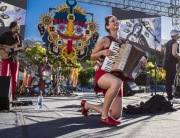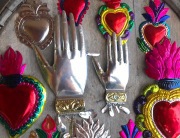From established, centuries-old traditions to inspiring innovations rooted in tradition, every artist—and every artwork—has a story. Here are five extraordinary examples of featured artists and cooperatives, determined to preserve tradition and create change in communities worldwide.
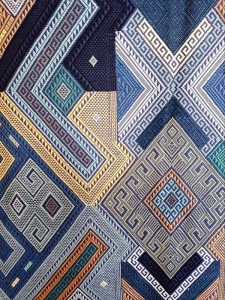 Ock Pop Tok
Ock Pop Tok
Country: Laos
Medium: Woven Silk Textiles
The Laotian cooperative Ock Pop Tok makes items as lyrical and beautiful as its name, but its mission is serious: everything the group produces is made by women, with the goal of enhancing the quality of life for as many artisans—and in turn, their families—as possible. What began as a small workshop of five female weavers in 2000 has since blossomed into one of the largest and most well-respected textile producers in Southeast Asia—with multiple locations employing 400-some highly skilled artisans.
Ock Pop Tok translates to East Meets West: a fitting moniker for an enterprise that was the brainchild of an Englishwoman, Jo Smith, and a Laotian woman, Veo Duangdala. The pair met while Smith was visiting Laos on a photography assignment; once she met Veo she immediately fell in love with her unique hand-loomed weavings. For her part, Veo was eager to expand her workshop. The two women joined forces, united in their dream of sharing ethically produced, sustainable hand-woven textiles with the world. Weaving has a rich tradition in Laos, where women have been creating silk textiles for over 1,000 years. The practice has been passed down from generation to generation; it’s long been customary for women to breed silk worms, color the silk with dyes derived from plants, and then weave fabric for themselves and their families. Given the size of Ock Pop Tock, it’s no surprise that items are as varied and unique as the women who make them: this translates into home goods such as pillows emblazoned with vibrant, zig-zagging patterns, and also into wearable items such as elegantly refined silk-sheath dresses with subtle patterning and rich, nuanced colors.
 CARLA FERNÁNDEZ
CARLA FERNÁNDEZ
Country: Mexico
Medium: Textiles, Apparel, Beadwork
For her second journey to Santa Fe for the International Folk Art Market, Mexican fashion designer Carla Fernández will again wow visitors with her uniquely modern take on ancient design motifs. “My passion is the architecture of clothes,” says Fernández. Her design purpose is rooted in childhood travels across Mexico with her father, then director of the National Institute of Anthropology and History. “These journeys familiarized me with the clothing worn by indigenous peoples in each area. I was amazed by the beauty of traditional Mexican costumes, and I decided to dedicate my life to show its contemporary capability in terms of design.”
Today, Fernández and 94 indigenous artisans from communities across Mexico work together, reinterpreting traditional Mexican garment materials and shapes to fit today’s fashion-forward consumers. Her innovative designs illuminate materials and techniques honed through the centuries by artisans from Chiapas, Hidalgo, Puebla, Mexico City, and beyond. Whether made from organic cotton or recycled leather, each garment represents the highly specialized artistic practices and processes of her partner artisanal groups—including waist loom and pedal loom weaving, hand embroidery, hand cut leather fretwork, mud dyeing, wool felting, and more.
Fernández’s sophisticated collections reinterpret the geometry of traditional Mexican clothing, which involves complex systems of pleats, folds, and stitching. Her tunics and dresses are trimmed in traditional rebozo (shawl) fabrics. Poncho pockets and trims boast applied leather fretwork. Blouses feature frontal beadwork or other strategically embroidered applications. Fernández says these adornments are the result of “work with communities that ask us to develop new designs in collaboration with them.”
To that end, Fernández’s mobile fashion design laboratory travels to indigenous communities for textile workshops. Both groups benefit as artisans and designers exchange ideas and develop new products, an approach that has gained Fernández international acclaim for sustaining ancestral indigenous textile techniques and providing sustainable livelihoods for artists.
“The garments we create prove that tradition need not be static, nor fashion ephemeral,” Fernández says. “We only simplify the garments to be worn by a more urban customer. That allows the artisan to take less time for the same precious work in a garment so they can have more time with their families and higher economic compensation for their designs. I am sure that through radical design can we prevent Mexican handicrafts from fading away.”
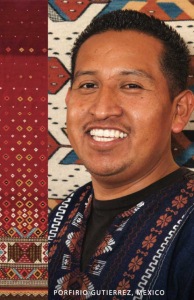 PORFIRIO GUTTIÉREZ
PORFIRIO GUTTIÉREZ
Country: Mexico
Medium: Weavings
Master weaver Porfirio Gutiérrez doesn’t just make art, he also preserves the ancient traditions of his Zapotec background. According to a recent profile of Gutierrez in The New York Times, “Mr Gutiérrez is descended from a long line of weavers. His father taught him to weave as a child; he even wove the backpack he took to school.” Now, Gutiérrez is known as a master of the art form. Raised in the mountainous village of Teotitlan del Valle, Gutiérrez learned as a child which plants to gather to create the best dyes.
His focus on using sustainable, regionally resourced materials continues today, and he has urged both fellow weavers and consumers to seek out natural dyes and naturally dyed fabrics whenever possible. Synthetic dyes are affordable and ready-made, but cheap chemical dyes not only produce inferior colors, they also prevent artists from maintaining centuries-old tradition of gathering dye materials themselves, and learning the highly specialized process of creating colors for their weavings. This is the impetus behind Gutierrez’s goal of preserving natural dyes and corresponding traditions in his homeland.
Gutiérrez’s preservation of ancient art-making methods is something of a counterpart to the fiercely innovative approach he uses when incorporating new designs into his creative repertoire. Gutiérrez has achieved international acclaim for his modern interpretation of traditional Zapotec designs, and his work is held in numerous private and public collections, including the National Museum of the American Indian in Washington, D.C., and the Museum of Ventura County in California. Currently Gutiérrez lives and works in the United States, offering workshops, weaving demonstrations, and participating in a range of exhibitions.
In 2017, a selection of the Gutiérrez family’s dye materials were added to the Harvard Art Museums’ Forbes Pigment Collection, the world-renowned archive of artist materials. In January 2018, Gutiérrez spoke about natural dyes and colorants to an audience at The University of California, Berkeley’s Hearst Museum of Anthropology. There, he eloquently explained that the some of the materials he uses are not only important for their superior artistic applications, but also because they have played an integral role in global trade—meaning their use extends not just regionally, but inter-continentally.
 RUPA TRIVEDI
RUPA TRIVEDI
ADIV PURE NATURE DYEING TEAM
Country: India
Medium: Textiles
Following a hugely successful inaugural year in 2017, India’s Adiv Pure Nature cooperative will be returning to the Market this summer. Adiv’s hand-dyeing team creates exquisite natural-dyed fabrics for scarves, garments, jewelry, and more. Their flagship Temple Blessings Project is a uniquely innovative initiative in which offerings at local Hindu temples—including marigold, coconut husk, hibiscus, and rose—are recycled into dyes and materials for steamed textured prints. Before Adiv, the offerings were discarded in the sea, polluting Mumbai’s sacred temple areas. Now, they are collected and sorted by elder Adiv team members, then dried and processed for use in silk and cotton textiles made by hand-weavers from Maharashtra, Bengal, and Maheshwar.
In the urban Mumbai community of East Andheri, India, time-honored connections to the materials and processes that produce natural dyes for vibrant Indian silks and cottons have been lost to the ease and accessibility of chemical colorants. In 2008, however, Rupa Trivedi, an ultrasonic engineer, set out to reclaim the power of natural plants and flowers. From a few experimental dye pots in her kitchen, she cooked up Adiv Pure Nature. The company provides social opportunity and creative education and expression for a team of predominantly female, low-income workers in this densely populated corner of Mumbai, while drawing an international clientele, including dosa, Eileen Fisher, Johanna Riplinger, Anthropologie, and others.
Adiv’s on-the-job training program emphasizes sustainability and handmade creativity. Artists not only learn about dyeing and design, but about water recycling, composting, and non-toxic ecological practices. In addition to flowers from the temple project, team members utilize natural waste products such as onion peel and coconut from street vendors and restaurants; organic flowers from small Mumbai-area farmers; and food-grade ayurvedic materials including pomegranate peel, harda, annato, madder, and indigo. It all translates to income, health care, and other quality-of-life benefits for the Adiv team and their families.
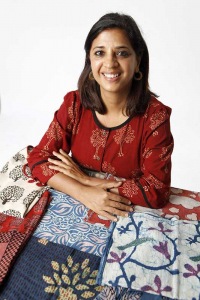 MEETA MASTANI
MEETA MASTANI
Country: India
Medium: Textiles
Meeta Mastani is a master printmaker. Using a process refined over decades, she applies traditionally inspired designs to a range of wearable and decorative textiles. Mastani will be featured in the 2018 Market’s Innovation section of artists, due in part to her use of ancient techniques in utilitarian garments such as T-shirts. For the first time at the International Folk Art Market, T-shirts will be on offer, featuring Meeta’s uniquely contemporary dye process, with whimsical additions of flip-flops, umbrellas, and yin-yang symbols, to name just a few. The impulse of merging traditional symbols with contemporary motifs is apparent across many items designed by Mastani. This means a blouse might be adorned with simple diamond shapes or wavy lines, but also that one of Mastani’s shirts could have patterning that mimics traditional Indian bell tota: delicate, colorful strands of small bells and beads, interspersed with cloth bird forms.
For over twenty-five years, Mastani worked in sustainability and community development. From this commitment to local communities sprang the company Bindaas Unlimited, which Mastani co-founded as a fair-trade textile and craft business. This multi-faceted set of interests and skills has allowed Mastani to work alongside artisans both in her native India and abroad; she especially enjoys collaborating in the realm of printmaking, which has allowed her to start online and offline retail markets, as well as offer her services as a consultant of merchandising and branding.
Collaboration between artisans from communities near and far is of crucial importance to Mastani’s practice. In her words, “These craftspeople have been our gurus and a window into a whole other way of living and being.” In addition to her decades-long career as a fine artist, Meeta Mastani is a writer, lecturer, social activist, and even a professor: in 2016 she was an artist-in-residence at The University of Wisconsin, where she instructed students in print-making.
For information, interview requests, and photos for any of the artists and collectives at the International Folk Art Market, please contact Clare Hertel at 505-474-6783 or clare@clarehertelcommunications.com.


